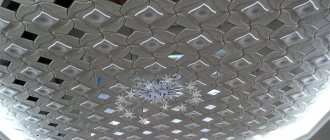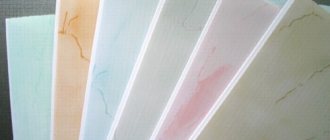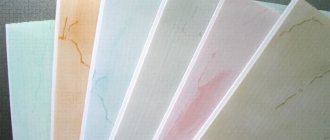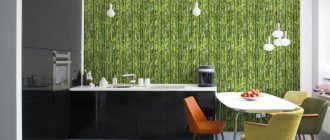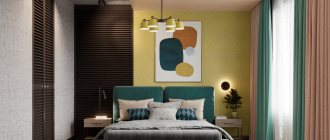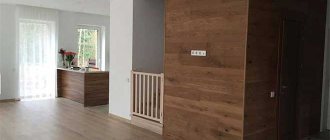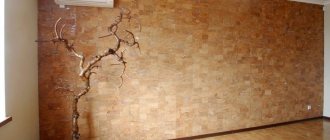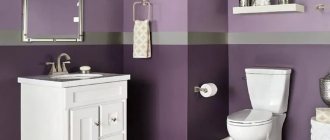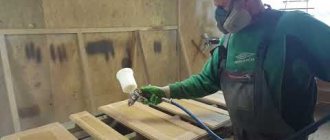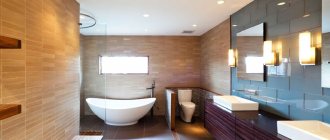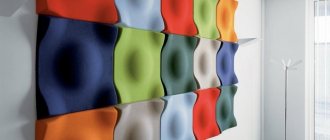The kitchen walls can be decorated in any style and direction. Materials such as MDF panels for kitchens are in demand and popular due to their practicality and aesthetic appearance. Walls above the sink level and surfaces are always subject to contamination and splashes of grease. To successfully resolve this issue, you need to select the optimal design option for the kitchen apron.
Decorative panels based on MDF are budget finishing materials
Kitchen design with MDF panels (photo selection)
Modern material is made in different styles and with different textures. Some of the most popular ones are laminated or veneered models, which are made to look like natural wood: pine, alder, mahogany, maple. The surface can be any - glossy or matte, optionally decorated with an image (photo printing or 3D effect).
In the interior of the kitchen, MDF panels can be used for full or partial cladding of walls, ceilings and other surfaces
Panels made “to look like stone” are not inferior. The material comes in different interpretations; there are even models made to look like metal or glass. The “openwork” sheets look beautiful and neat. If desired, they can be combined with any finish. Using MDF panels for the kitchen is beneficial, as it is not only practical, but also very beautiful. Natural wood can crack from moisture and steam; this cannot happen on artificially created smooth panels.
Wall decoration
Various design techniques are used in the interior. Different materials are used to place accents, and decoration is done with materials of different textures.
If the kitchen work area is where the action happens, it can be decorated in bright colors and have bold accents. The dining area is the part of the room where people eat. It should be comfortable and cozy. Juicy colors are not allowed here. As a rule, this wall is completely decorated with material. And if recently wallpaper was used as a material, now it is MDF panels. This cladding is much more profitable than tiles and other finishing options:
- high quality material. The walls are protected; they are not damaged by scratches or rubbed off. Kitchen renovations will have their original appearance for a long time;
- Using different textures and colors you can divide the dining area. Thanks to the variety of colors, it is possible to create a unique interior;
- MDF panels can visually expand the space. They are used in rooms with a small area;
- the price of such material is lower than tiles, but higher than wallpaper. At the same time, the quality and durability are better than these materials.
Provence style
According to designers, MDF structures are the best option for decorating walls in the kitchen. If this room is spacious, has a rectangular shape, or is combined with the living room, you can use panels to create a partition, visually separating them. These can be panels that resemble clapboards and have a varnish coating.
In rooms with a small area, this material is used to trim the opposite side from the working side. These can be models with either photo printing or regular seamless sheets, cut to fit the available area.
Veneer boards or beautiful patterns should be chosen with a natural shade. It is suitable for the dining area. This material will be more beautiful than ordinary tiles and more practical than wallpaper.
MDF is the best option for decorating walls in the kitchen
MDF material - what is it?
What does MDF mean? The abbreviation is translated as “fine fraction”. The manufacturing process uses wood fibers with average densities. They are pressed together under high pressure and temperatures. To make the panels stronger, the composition contains a binding component - resin. The production produces standard models, but you can get the required sizes for an individual order.
Wall panels are sold ready-to-install and can be painted, laminated or veneered
There are certain GOSTs, according to which MDF passes as an environmentally friendly raw material, ahead of many types of wood.
Ceiling
Ceiling finishing materials are quite fragile and light in weight. If the material is not handled carefully, there is a high risk of dents appearing, which will ruin the appearance.
Ceiling panels are manufactured in a wide range of widths, colors and texture imitation - including wood and marble. The surface can be either matte or glossy. Gloss is acquired through a special varnish coating. There are options on sale with a pattern obtained by applying printing or thermal film. The printing is applied to the panel itself and, unlike thermal film, requires specialized equipment, so its cost will be slightly higher.
The panel ceiling, among others, has special advantages:
- allows you to hide uneven ceilings, wiring and small diameter pipes;
- if the neighbors are flooded, the panels will simply dry without deformation or damage.
- They are not afraid of temperature changes, have no odor and are absolutely safe.
The only caveat: the profiles used for installation will slightly reduce the usual ceiling height.
Advantages and disadvantages of MDF as a finishing material
MDF panels for the kitchen have the following advantages:
- no need to pre-prepare the surface for installation;
- the finish is perfectly polished and does not crumble;
- environmentally friendly material, does not harm human health;
- it is quickly and easily cleaned from dirt and dust, and there is no debris or waste during installation;
- good price-quality ratio, accessibility for everyone who wants to make repairs;
- finishing can be done on your own, without the involvement of craftsmen.
MDF panels are available in a huge range of design solutions - you can choose an imitation of stone or wood, or choose a material to match the tabletop
There are also disadvantages:
- the panels are not friendly with moisture in large quantities and negatively perceive temperature changes;
- if you do not cover the material on top with a special fire-prevention device, there is a risk of fire;
- MDF sheets of small thickness can be easily damaged as a result of transportation or mechanical stress.
Such panels are equally suitable for finishing walls and ceilings, and their installation does not require careful leveling of surfaces
Price overview
And the last question that interests buyers of MDF kitchen aprons is the price. The cost of full-size panels with photo printing 60 cm high is 1500-1800 rubles. Options with imitation brick, wood, stone, tiles will cost in the range of 800-3000 rubles, depending on the thickness of the material (2 or 4 mm). Also, during installation you will need special mounting glue, which costs another 250-300 rubles. per package.
Support the project - share the material with your friends on social networks:
Choosing a design
Kitchen panels made from high-quality MDF are distinguished by a large assortment and different designs. You can buy something for every taste: ash, wood shavings, imitation stone, brick. Focus on a well-known manufacturer: this will always help you choose good material.
Wall panels must be selected taking into account the design of the kitchen in general and the furniture in particular - you can focus on the color and texture of facades, countertops, flooring or curtains
Before choosing a separate option, let’s consider the type of coatings with which the slabs are produced:
- laminate;
- paper;
- veneering;
- surfaces that repel water.
It’s worth choosing according to your design and type of room. A water-repellent, fire-resistant coating is ideal for the kitchen.
Wood-effect kitchen apron
If you want a wooden panel, but are not willing to spend a lot on it, the best solution is an MDF panel. It exactly imitates wood texture and is inexpensive. Good MDF panels are practically indistinguishable from their natural wood counterparts.
Interesting solutions in the interior design of a private house and apartment (photo selection)
Thanks to the large assortment, you can beautifully decorate any room, and the variety of textures helps to create truly stylish compositions. Textures like wood or natural stone look impressive. When selecting MDF sheets, consider the functionality of the space and zoning. If the kitchen is made in a classic style, you can focus on brightness and add creativity. A combination of light and dark shades looks good.
A successful combination of a solid wood tabletop and a section of wall in the dining area with wood paneling
In a kitchen combined with a dining room, you can combine the paneling - decorate the lower part in a dark color, add pastel on top or... You can use a wooden plank to emphasize the contrast. Striped trim visually expands the space. A good option is laminated panels imitating natural wood or stone. Veneer boards are similar in structure to wood - they look impressive and beautiful.
Classic solution for kitchen interior - dark bottom and light top
Using MDF panels you can create a unique and extraordinary interior
MDF boards have good qualities compared to ceramic tiles - they are easy to clean and look much more impressive and more expensive. If you choose several shade options, you can zone the space in an interesting way, highlighting the dining and cooking area. Partitions with wall panels look good. Here you should prefer veneered or varnished surfaces. Kitchens made from MDF panels with photo printing, photos of which can be viewed on the Internet for inspiration, look very original.
Decor with wood panels on the walls in the kitchen dining area
Classification
Wood boards are used for production. Depending on the technology used, they acquire different properties and appearance. They can be divided into groups:
- Solid pressed – panels are manufactured under pressure. They have a smooth surface on both sides. Such models are covered with a protective layer.
- Laminated - after the main production stage, one side is coated with film. It protects the surface from damage and gives it a glossy or matte shine.
- Moisture-resistant sheets are a universal material. It hides the imperfections of the walls - all their unevenness, and is not damaged by moisture. Externally, the sheets resemble plastic; they feel smooth and even to the touch.
The boards have a dense structure that does not allow moisture to pass through
According to the method of decorating the front surface:
- Glossy panels. The material is often used in the production of furniture facades. The MDF surface is protected with a dense layer of polyester or primer. The primer has enhanced properties and qualities: it forms a mirror-glossy surface that is resistant to scratches and other damage.
- Veneered – have the texture of natural wood. For imitation, a thin layer of natural wood veneer is used, which is applied after the final stage of manufacturing the boards.
- Painted panels – after manufacturing, the surfaces are covered with paint of different colors. It smooths out irregularities and gives them a beautiful look. The material is painted with damage-resistant paint of any shades and tones.
- Panels with 3D effect. This is a chance to create a custom design. Decorative MDF panels with 3D effect - know-how in the construction market. This method consists of applying imitation waves, geometric shapes, carvings, and relief to the finishing material by painting it in various colors. Decorating a room with such material helps solve the most complex design ideas.
They have a dense structure that does not allow moisture to pass through
By form:
- Lining or slatted - rectangular shaped slats are made. They can be made in different widths. To fasten them together, locks are created along the length of each panel. This material can be used for walls and ceilings. The lining has two types: small panels up to 1 meter in length and structures whose length reaches 2 meters.
- MDF sheet panels - used for finishing walls and ceilings. Available in large sheet sizes. If you use them during installation, the picture will be seamless. They may have a design on the front side.
- Tile - imitate tiles. Installation takes place according to the rack and pinion principle - groove, hook. The material is used for covering surfaces located close to the worktop.
The material is resistant to high humidity
The thickness of the slabs can be different:
- the thinnest. The material has a thickness of 5 to 9 mm. It has low weight and low strength. Most often used to decorate the ceiling in the kitchen. Such models are easily damaged, so they cannot be used for cladding walls or aprons;
- average thickness from 10 to 18 mm - used for cladding walls in the kitchen and in the manufacture of furniture. This is a strong material, but during installation it takes up useful space;
- the largest thickness is from 19 to 38 mm. They are used for cladding walls and floors. They are effective in private homes when you need to solve two problems: make the walls beautiful, smooth, and insulate the room. They are used in apartments as flooring, as well as facing end walls.
The material is difficult to damage: scratch, make a dent
MDF coated with plastic is considered resistant to surface damage, environmentally friendly – with natural veneer veneer, and spectacular – with photo printing.
Wall panels can also be divided according to texture - smooth or textured. Smooth models visually increase the space. They are used when covering the walls of kitchens that have a small area. But relief models look more impressive. They show less visible damage that is inevitable during operation. They are easier to care for.
How to choose a good MDF panel
The material is relatively inexpensive, but it is important to pay attention to quality. How to understand what material is considered good:
- There must be quality certification - you have every right to ask to see the document during the selection process. If it is present, it means that the material does not contain harmful components (resins and formaldehyde).
- There cannot be many defective elements in a batch - this indicates low quality.
- The colors of the products must be the same, and the coating must be uniform.
Well-known manufacturers, as a rule, value their reputations and produce high-quality products. It’s better to overpay for a brand than to run into a material that will wear out after a while and begin to smell of formaldehyde
MDF boards are distinguished by good characteristics, naturalness and safety. This is a good option for finishing a kitchen surface, which is not only of high quality, but also very attractive in appearance.
Installation methods
Among the main methods of installing a kitchen apron, we highlight the placement of slabs on a specially prepared frame and fastening with construction adhesive.
When using a frame, it is much more convenient to place the necessary sockets and switches on the wall . But this method is also more time-consuming. Working with glue is very simple and quick, but in the future dismantling such a panel will require much more time and effort. And this method is considered less environmentally friendly, since the glue can release harmful substances when heated. Consider these features when choosing an installation method. Let's look at them in more detail next.
Glue mounting
It is used, as a rule, for light panels when decorating ceilings and walls; it is suitable only for flat surfaces, with defects protruding no more than 3 mm.
Important! When working with glue, use a respirator and rubber gloves. Ventilate the room regularly.
At the initial stage, the surface is cleaned of old tiles, wallpaper and other finishing materials and primed. Next, to begin work, a metal profile is nailed to the lower level of the future structure. It takes on the weight load and serves as a level to maintain horizontal lines.
The glue is applied around the perimeter of the material in any convenient way. When using small panels, only cover the tiles, but when working with large forms, you can apply glue to the working wall.
Installation begins from a corner, observing all vertical and horizontal levels , and then moves along the entire working surface. At the same time, for the tightest fit, the panels are tapped with a special rubber mallet.
Note. The smaller the size of the panels, the more often it is necessary to check the level of compliance with horizontal and vertical lines during installation and, if necessary, correct them as soon as possible.
Which glue to choose is up to everyone to decide for themselves . Liquid nails are suitable for a beginner; experienced ones use universal adhesives or polyurethane foam.
Installation of panels on the frame
This option is great for hidden wiring and if the walls have significant unevenness. Sequence of work :
- a primer is applied to the working surface to protect against fungus, and the wooden parts of the frame are also treated with it;
- prepare markings for placing slats (approximate guidelines: 5 cm from the floor and ceiling and 50 cm between slats);
- using self-tapping screws, place slats on the wall according to pre-prepared markings;
- begin fixing the panels from the corner and regularly check the accuracy using a level;
- the panels are fixed to the sheathing using small nails, which are then hidden behind decorative elements;
- After installing all the panels, decorate the corners and baseboards, and place decorative fittings.
Note. For additional protection of the kitchen apron, you can use a glass screen or choose special MDF skins with a heat-resistant plastic coating.
Photo: MDF panels in the kitchen interior
Characteristics, pros and cons
So, briefly about the material:
What is good about an MDF kitchen apron? We can name at least eight of its main advantages:
But this material has its drawbacks:
